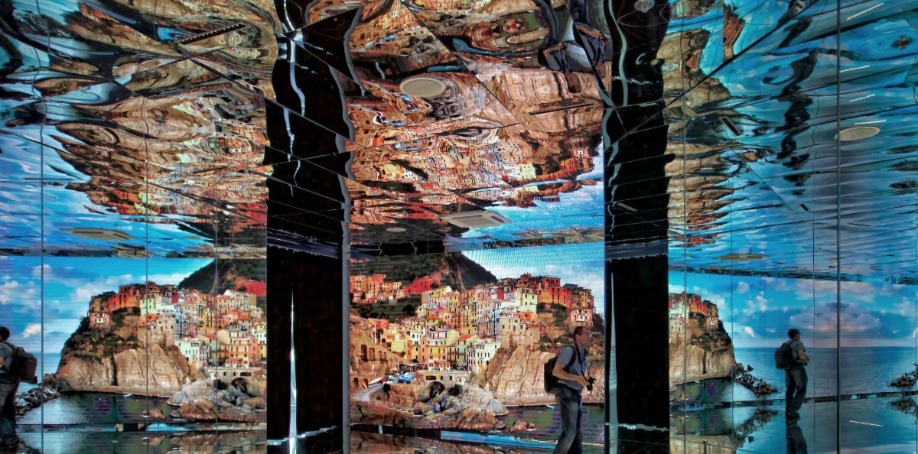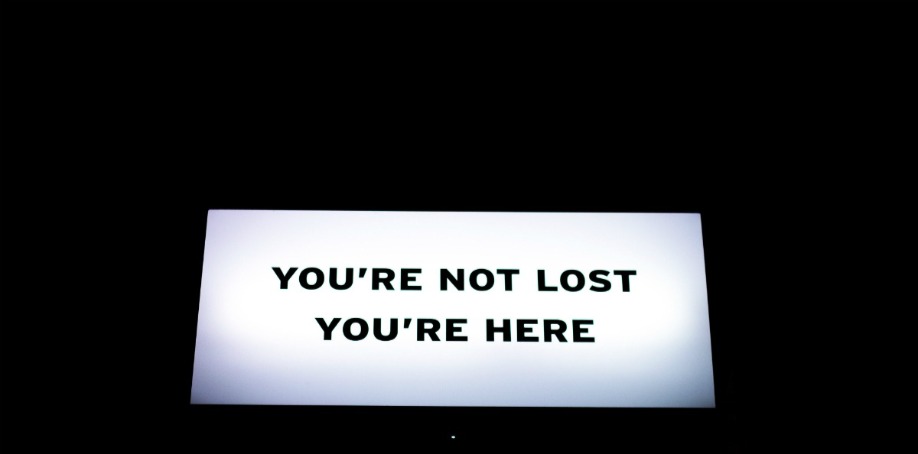
AV equipment has long been relied upon to make buildings more human-centric. Digital signage has traditionally been the first choice when it comes to information boards and wayfinding. It is ubiquitous in hospitals, museums and public buildings.
But now it's projection mapping's turn. While its most popular use case now is redesigning the facades of properties, projection mapping can do a lot for the navigability and utility of a building's interior, too.
Any Surface Can Become a Source of Information
Projection mapping offers AV installers and event planners the ability to transform any wall into a customizable source of information. This is particularly useful when the needs of a room or building change on a weekly basis.
Take a conference hall, for instance. Event planners can use projection mapping to create an information radiator, says the team at Meeting Tomorrow. This allows them to “easily and unobtrusively share reminders about upcoming sessions, agenda changes, event highlights, and local information such as weather forecasts.”
It doesn't matter what shape the room is, either. Alan Brawn of the Digital Signage Experts Group notes that your options are limited when you want to go really big with digital signage. Trying to transform an entire corridor with screens is going to be cost prohibitive and a logistical nightmare. But it is easily achievable with short-throw projectors that are installed in the ceiling and edge-blended seamlessly.
You don't even need flat surfaces either, notes Graham Cooke, market analyst for professional displays at Futuresource Consulting. Projection mapping allows for signage to be placed on surfaces that couldn't support screens.
Projection mapping can also be used throughout a building to direct visitors and encourage them to take particular actions. Wayfinding is a crucially important part of a building's user experience, says Stephen Peate, creative director at London agency Fabrik. “The wayfinding design process is about guiding and supporting your visitors when they come to your destination,” Peate writes. “The right signage helps your user to discover a space on their own, instead of forcing them to ask for help or struggle without assistance.”
Projection symbols make for ideal wayfinding in crowded spaces, sustainability specialist Shawna McKinley says. Physical installations can be difficult and expensive to install in many buildings, but projection is an ideal way to highlight the location of important amenities — even more so when those amenities are likely to change location.
Interior designers can take this idea one step further and use projection mapping to encourage audiences to take a specific action, says Epson. Nightclubs use projection mapping to direct patrons to the dancefloor. Museums use trails of light to guide audiences around exhibits. Projection mapping can be used to the same effect in your building.

Rooms Can Be Personalized in an Instant
The more versatile a building is, the greater convenience it offers to occupants. Few things can transform a room more quickly or more completely than projection mapping. This allows event planners to instantly transport guests to any place in the world without ever leaving the room, notes the team at Wedding Market.
The ease with which projected content can be changed also makes timing and managing event much easier, saysEncore Event Technologies. “If a space needs to be reset from lecture to cocktail mode, projected theming and branding doesn't get in the way like a physical set, one button press and the reset is done.”
Projection mapping isn't the preserve of event managers in this regard, however. It can also be used by visitors to personalize a building or room to their own tastes. The technology is currently being employed in the hospitality sector, where hotels use projection mapping to allow guests to change a room's décor to their own tastes.
“It can be a nice sleeping room if you like dark and quiet, but maybe not that fun and that's what we would like to change,” says Christian Lundén, director of future business at Nordic Choice Hotels. “By having 3D video projected to the walls, it feels bigger. We like guests to ask for these rooms and brag about it instead of maybe be booked last.”
Spaces Become Collaborative and Interactive
The more easily visitors can interact with a building, the more useful it becomes for them. This is particularly true in conference rooms, where the success of business meetings can depend on the level of collaboration that a room allows.
When it comes to getting a large group of people to engage and collaborate, being able to see the content is critical. Larger screens aren't an option, however. Wendy Cox, director of product development for Da-Lite, notes that “as flat panel resolution increases, pixels get smaller.” This is a huge problem in conference rooms and can lead to employees struggling to follow along or switching off completely.
Besides, meetings are rarely suited to having everyone huddles around a single screen. That's why using a projector to increase the size of content is the best solution in the vast majority of cases, says Alec Kasper-Olson at AVI Systems.
The applications of projection mapping in an office are virtually limitless. As well as transforming presentations as described above, projection mapping can also be used to facilitate collaboration by creating a giant digital workspace and touch-activating the projection like a smartphone screen.

Where Projection Mapping Excels Over Other AV Solutions
In some cases — though not all — projection mapping can provide even more effective solutions than traditional AV can.
For one, projection mapping offers superior redundancy compared to flat screen displays. A single broken screen can ruin an entire information board, but that doesn't have to happen with projection mapping. That's because projections can be stacked on top of one another. If one projection fails, another is there to take its place, saysRichard Ventura, VP of business development and solutions for NEC Display Solutions. That makes projection mapping ideal in emergency use cases where failure is not an option.
What's more, projection mapping can be an energy-efficient AV solution. This is a big selling point for many customers, says Bas Van Heek, strategic marketing manager at Cinionic in Belgium. Laser phosphor provides a lamp lifetime of up to 40,000 hours, which translates to more than six years of operation, Van Heek writes.
The improvement in laser technology also means projection mapping requires less maintenance, less noise and more consistent quality, notes Tom Lewis, project manager at UK-based integrator Anna Valley.
All AV solutions have the ability to make a building more useful. But projection mapping excels in areas where more traditional solutions such as digital signage and flat screens fail. No longer do event planners or interior designers have to hope for the perfect surface to work with. Any surface will do. Nor do they have to worry about excessive costs, flexibility or usability.
Projection mapping offers a solution that can make virtually any space more convenient and human-centric.
Images by: Ricardo Gomez Angel, Taras Bulba, Campaign Creators


